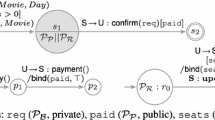Abstract
In this paper, we describe the CognitiveAgents Specification Language (CASL), and exhibit its characteristics by using it to model the multiagent feature interaction resolution system described by Griffeth andVelthuijsen [7]. We discuss the main features of CASL that make it a useful language for specifying and verifying multiagent systems. CASL has a nice mix of declarative and procedural elements with a formal semantics to facilitate the verification of properties of CASL specifications.
This research was funded by Communications and Information Technology Ontario and the Natural Science and Engineering Research Council of Canada. We thank Fawzi Daoud for suggesting that we look at feature interaction applications and Griffeth and Velthuijsen’s work in particular.
Access this chapter
Tax calculation will be finalised at checkout
Purchases are for personal use only
Preview
Unable to display preview. Download preview PDF.
Similar content being viewed by others
References
D. Bjorner and C. B. Jones. The Vienna Development Method: The Metalanguage, volume 61 of LNCS. Springer-Verlag, 1978.
Ph. Du Bois. The Albert II Language-On the design and the Use of a Formal Specifi-cation language for Requirements Analysis. PhD thesis, Department of Computer Science, University of Namur, 1995.
F. Brazier, B. Dunin-Keplicz, N. R. Jennings, and Jan Treur. Formal specifications of multi-agents systems: A real-world case study. In Proceedings of the First International Conference on Multi-Agent Systems (ICMAS’95), pages 25–32, San Francisco, CA, June 1995. Springer-Verlag.
A. Dardenne, S. Fickas, and A. van Lamsweerde. Goal-directed requirements acquisition. Science of Computer Programming, 20:3–50, 1993.
Joeri Engelfriet, Catholijn M. Jonker, and Jan Treur. Compositional verification of multi-agent systems in temporal multi-epistemic logic. In J. P. Müller, M. P. Singh, and A. S. Rao, editors, Intelligent Agents V: Proceedings of the Fifth International Workshop on Agent Theories, Architectures and languages (ATAL’98), volume 1555 of LNAI, pages 177–194. Springer-Verlag, 1999.
Giuseppe De Giacomo, Yves Lespérance, and Hector J. Levesque. ConGolog, a concurrent programming language based on the situation calculus. To appear in Artificial Intelligence.
Nancy D. Griffeth and Hugo Velthuijsen. Win/win negotiation among autonomous agents. In Proceedings of the 12th International Workshop on Distributed Artificial Intelligence, pages 187–202, Hidden Valley, PA, May 1993.
D. Kinny, M. Georgeff, and A. S. Rao. A methodology and modelling technique for systems of BDI agents. In W. Van der Velde and J. W. Perram, editors, Agents Breaking Away, pages 56–71. LNAI 1038, Springer-Verlag, 1996.
Gerhard Lakemeyer and Hector J. Levesque. AOL: a logic of acting, sensing, knowing, and only knowing. In Proceedings of Knowledge Representation and Reasoning (KR-98), pages 316–327, 1998.
Hector J. Levesque, Raymond Reiter, Yves Lespérance, Fangzhen Lin, and Richard B. Scherl. GOLOG: A logic programming language for dynamic domains. Journal of Logic Program-ming, 31:59–84, 1997.
John McCarthy and Patrick J. Hayes. Some philosophical problems from the standpoint of artificial intelligence. In Bernard Meltzer and Donald Michie, editors, Machine Intelligence 4. Edinburgh University Press, 1969.
S. Owre, S. Rajan, J. M. Rushby, N. Shankar, and M. K. Srivas. PVS: Combining specification, proof checking, and model checking. In Rajeev Alur and Thomas A. Henzinger, editors, Computer-Aided Verification, CAV’ 96, volume 1102 of Lecture Notes in Computer Science, pages 411–414, New Brunswick, NJ, July/August 1996. Springer-Verlag.
Raymond Reiter. The frame problem in the situation calculus: A simple solution (sometimes) and a completeness result for goal regression. In Vladimir Lifschitz, editor, Artificial Intelli-gence and Mathematical Theory of Computation: Papers in Honor of John McCarthy, pages 359–380. Academic Press, San Diego, CA, 1991.
Richard B. Scherl and Hector J. Levesque. The frame problem and knowledge-producing actions. In Proceedings of the Eleventh National Conference on Artificial Intelligence, pages 689–695, Washington, DC, July 1993. AAAI Press/The MIT Press.
Steven Shapiro. PhD thesis. In preparation.
Steven Shapiro, Yves Lespérance, and Hector J. Levesque. Specifying communicative multi-agent systems. In Wayne Wobcke, Maurice Pagnucco, and Chengqi Zhang, editors, Agents and Multi-Agent Systems — Formalisms, Methodologies, and Applications, volume 1441 of LNAI, pages 1–14. Springer-Verlag, Berlin, 1998.
Steven Shapiro, Maurice Pagnucco, Yves Lespérance, and Hector J. Levesque. Iterated be-lief change in the situation calculus. In A. G. Cohn, F. Giunchiglia, and B. Selman, editors, Principles of Knowledge Representation and Reasoning: Proceedings of the Seventh Interna-tional Conference (KR2000), pages 527–538, San Francisco, CA, 2000. Morgan Kaufmann Publishers.
J. M. Spivey. The Z Notation: A Reference Manual. Prentice Hall, 1989.
M. Wooldridge, N. R. Jennings, and D. Kinny. A methodology for agent-oriented analysis and design. In O. Etzioni, J. P. Müller, and J. Bradshaw, editors, Agents’ 99: Proceedings of the Third International Conference on Autonomous Agents, Seattle, WA, May 1999. Lynn Andrea Steinau]20._Eric S. K. Yu. Modelling Strategic Relationships for Process Reengineering. PhD thesis, Dept. of Computer Science, University of Toronto, 1995.
Author information
Authors and Affiliations
Editor information
Editors and Affiliations
Rights and permissions
Copyright information
© 2001 Springer-Verlag Berlin Heidelberg
About this paper
Cite this paper
Shapiro, S., Lespérance, Y. (2001). Modeling Multiagent Systems with CASL - A Feature Interaction Resolution Application. In: Castelfranchi, C., Lespérance, Y. (eds) Intelligent Agents VII Agent Theories Architectures and Languages. ATAL 2000. Lecture Notes in Computer Science(), vol 1986. Springer, Berlin, Heidelberg. https://doi.org/10.1007/3-540-44631-1_17
Download citation
DOI: https://doi.org/10.1007/3-540-44631-1_17
Published:
Publisher Name: Springer, Berlin, Heidelberg
Print ISBN: 978-3-540-42422-2
Online ISBN: 978-3-540-44631-6
eBook Packages: Springer Book Archive




